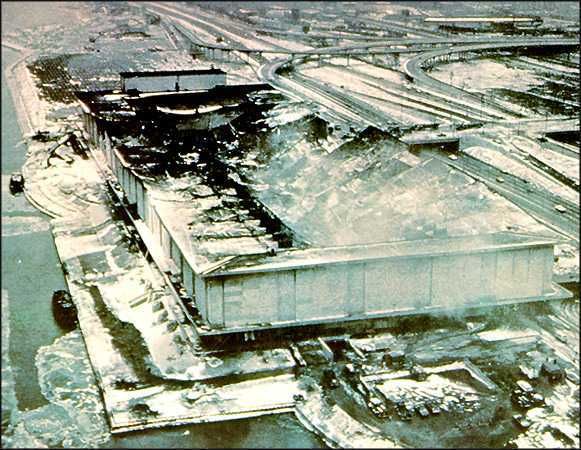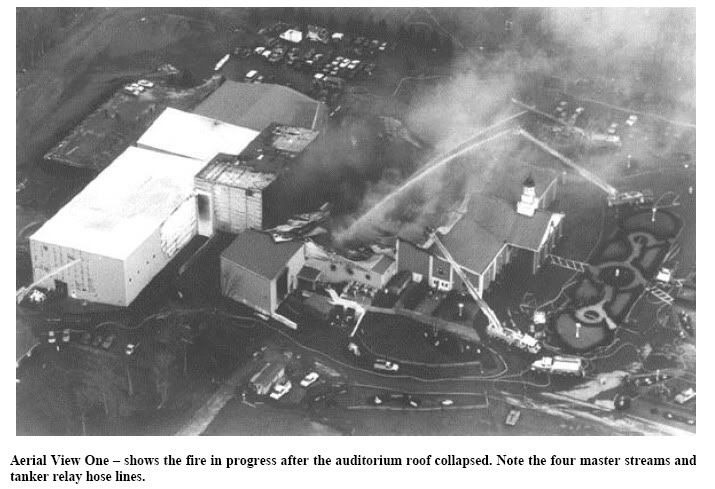Quote:
|
Originally Posted by fastom
So what you are suggesting is that all buildings should be expected to collapse in a fire and maybe having 1,000,000 square foot ranchers is the way to go for office buildings?
It's really odd that only the WTC buildings seem to collapse from fire even though there have been lots of other buildings that have had fires. But that was the day of many coincidences.
|
Based on the most stringent standard of the ASTM E119 test for fire survivability of materials, structural/firewalling members need to be able to survive for at most 4 hours (2 hours in some instances, I do not know what the code was for WTC7) in a time-temperature profile deemed to be attributable to a standard fire. The test assumes that sources of cooling or fire fighting will be taking place within that time frame. The observed events are that the fires burned for approximately 7 hours with no firefighting crews to put them out, and the point of failure seems to have occurred in the interior of the building - the area least likely to have external sources of cooling.
Interestingly, I ran across some stories about steel framed buildings collapsing from fires after I last posted. I do not know the veracity of the information, but at this point have no reason to doubt them:
Kadar Toy Factory Fire, May 10 1993 (
http://web.archive.org/web/200703070...8&nh=0&ssect=0)
3 steel framed buildings collapsed, the cause seems to be lack of fireproofing
Quote:
|
Despite the fire-fighters' efforts, Building One collapsed completely at approximately 5:14 p.m. Fanned by strong winds blowing toward the north, the blaze spread quickly into Buildings Two and Three before the fire brigade could effectively defend them. Building Two reportedly collapsed at 5:30 p.m., and Building Three at 6:05 p.m. The fire brigade successfully kept the fire from entering Building Four and the smaller, one-storey workshop nearby, and the fire-fighters had the blaze under control by 7:45 p.m. Approximately 50 pieces of fire apparatus were involved in the battle.
|
McCormick Place Fire, January 16, 1967 (
http://www.chipublib.org/004chicago/...mick_fire.html)
Roof collapse, again attributable to lack of fireproofing

Sight and Sound Theatre, Lancaster, PA, January 1997 (
http://www.interfire.org/res_file/pdf/Tr-097.pdf)
Roof collapse. This building did have fireproofing on the structural members.

All of these buildings were rather short - the Kadar Buildings were the tallest at 4 stories. The McCormick and Sight and Sound buildings were shorter, which could explain why the walls did not fall when the roofs collapsed. It lends credibility to the hypothesis that fire *can* weaken the steel enough to cause collapse, and also lends credibility to the FEMA report that showed sections of WTC5 collapsed due to fire as well.
An archived article from Fire Protection Engineering Magazine also lends support to the temperature that building fires can reach (emphasis mine):
Quote:
http://www.fpemag.com/archives/artic...ue_id=27&i=153 (paragraph 11)
Two large department store fires in Athens, Greece, in 1980 are documented in the paper by Kyriakos Papaioannoa, 1986.4 These fires began at 3 a.m. on Dec. 19, 1980, with arson being suspected as the cause. The Katrantzos Sport Department Store was an 8-story reinforced concrete building. Its fire started at the 7th floor and rapidly spread throughout the building, due to lack of vertical or horizontal compartmentation and the absence of sprinklers. Collected evidence indicated that the fire temperatures reached 1000°C over the 2- to 3-hour fire duration, ...
|
Obervation seems to suggest that any building, if on fire for a long enough period without adequate fire fighting capability, *can* collapse, at least partially.
Quote:
|
I take those NIST findings with a grain of salt... OK a fifty pound bag of salt. It's making a cause to fit the results except where they can't explain, so they don't.
|
The NIST report is still in the hypothesis/theory stage, with simulations and data gathering ongoing. The questions posed by Will are based on whether the initial NIST hypothesis is credible:
Hypothesis: Fire burned in WTC7 sufficiently long to weaken key structural members.
~~~~Observation: Fires burned without any fire fighting control for approximately 7 hours. Evidence from other sources indicates that temperatures can reach sufficient value to weaken steel.
Hypothesis: structural members most likely on the interior of the East side failed and pancaked the floors in that area.
~~~~Observation: The east side penthouse collapsed approximately 6 seconds before global collapse began.
Hypothesis: After the east side collapsed, the load was transferred to the remaining structural members, which then failed horizontally east to west.
~~~~Observation: the roofline is seen to collapse from the east to west during the global collapse.
Hypothesis: the interior collapse pulled the exterior walls down at the same time, causing a compact collapse field typical of an interior failure mechanic.
~~~~Observation: The debris field *was* compact.
I understand that at this point they cannot be 100% sure (and maybe never can be more than highly probable), but which cause have they not explained, at least hypothetically?
Quote:
|
What do you think started those fires... inside a building? The NYC emergency command center was in there... you don't think somebody could have grabbed a red bottle off the wall and put the fire out right away?
|
The collapse of WTC1 sent flaming debris onto WTC5, 6, and 7. WTC5 and 7 were observed to catch fire after that, so it seems like a credible mechanism for fire initiation.
As for putting out the fire, that supposes that the buildings were still occupied. Since WTC2 collapsed before WTC1, they may have already been evacuated when WTC1 came down, but I do not know for sure. Were they to still be occupied, the next question would be at what locations the fire started - it appears from the pictures that the fire progressed South to North, indicating that they started in the South. After a bunch of debris gouged out a chunk on the south of the building, I don't know that I would stick around to check for fires at that point.